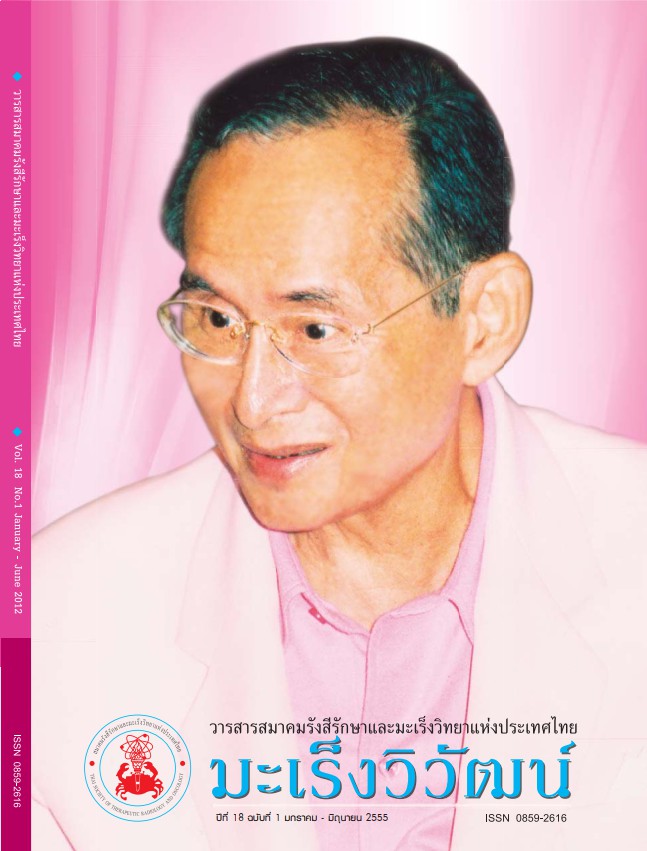ผลการรักษามะเร็งเต้านม โดยการรักษาแบบผ่าตัดสงวนเต้านมตามด้วยการฉายรังสี ที่ศูนย์มะเร็งชลบุร
Abstract
บทนำ การรักษาโรคมะเร็งเต้านมระยะเริ่มต้นโดยการรักษาแบบผ่าตัดสงวนเต้านมตามด้วยการฉายรังสี (Breast conservation therapy) ได้รับการยอมรับอย่างว่า เป็นการรักษาที่ได้ผลเทียบเท่ากับการรักษาโดยการผ่า ตัดเต้านมออกทั้งหมด (Modifi ed radical mastectomy) ซึ่งศูนย์มะเร็งชลบุรีได้ให้การรักษาแบบ breast conservation therapy มาตั้งแต่ปี 2541 การศึกษานี้เป็นการศึกษาวิจัย เพื่อรายงานผลการรักษาผู้ป่วยมะเร็งเต้านมที่ได้รับการรักษาแบบ breast conservation therapy ที่ศูนย์มะเร็งชลบุรี วัตถุประสงค์ ศึกษาผลการรักษามะเร็งเต้านมที่ได้รับการรักษาแบบผ่าตัดสงวนเต้านมตามด้วยการฉายรังสีที่ศูนย์ มะเร็งชลบุรี ในแง่ของอัตราการรอดชีวิต, อัตราการกลับเป็นซ้ำ, ผลด้านความสวยงาม, และภาวะแทรกซ้อน ระยะยาวจากการรักษา วัสดุและวิธีการ การศึกษาเชิงบรรยายแบบเก็บข้อมูลย้อนหลัง ของผู้ป่วยโรคมะเร็งเต้านมที่ได้รับการรักษาแบบผ่าตัด สงวน เต้านมตามด้วยการฉายรังสี ที่ศูนย์มะเร็งชลบุรี ตั้งแต่เดือนกันยายน 2541 ถึงเดือนธันวาคม 2553 ซึ่งข้อมูลที่ได้มา จากการทบทวนเวชระเบียนของโรงพยาบาล และประวัติการรักษาผู้ป่วยของกลุ่มงานรังสี รักษาและบันทึกลงในแบบฟอร์มเก็บข้อมูลวิจัย ผู้ป่วยจะได้รับการประเมินผลการรักษาและภาวะแทรก ซ้อนจากผลการตรวจครั้งล่าสุดโดยแพทย์ การวิเคราะห์ข้อมูลใช้สถิติเชิงพรรณนา รวมถึงคำนวณหาอัตราการรอดชีวิตและอัตราการรอดชีวิต โดยปราศจากโรคโดยใช้ Kaplan-Meier survival function ผลการศึกษา ระหว่างเดือนกันยายน 2541 ถึงเดือนธันวาคม 2553 มีผู้ป่วยเพศหญิงจำนวน 42 รายที่ได้รับการรักษาโดย การผ่าตัดสงวนเต้านมตามด้วยการฉายรังสี อายุตั้งแต่ 20-62 ปี อายุเฉลี่ย 44.5 ± 8.09 ปี ระยะเวลาติดตาม ผลการรักษา ตั้งแต่ 0.54-13 ปี ค่ามัธยฐานการติดตามผลการรักษาเท่ากับ 3.46 ปี พบว่าอัตรารอดชีวิต ปราศจากโรค และ อัตรารอดชีวิตที่ 5 ปี มีค่าเท่ากันร้อยละ 90.62 ผลด้านความสวยงามของเต้านมหลังการ รักษา พบว่าผลดีมากในผู้ป่วย 8 ราย (ร้อยละ 19), ผลดีในผู้ป่วย 13 ราย (ร้อยละ31), ผลพอใช้ในผู้ป่วย 12 ราย (ร้อยละ 28.6) และผลไม่ดีในผู้ป่วย 3 ราย (ร้อยละ7.1) ในส่วนของภาวะแทรกซ้อนจากการรักษาใน ระยะยาวพบมีผู้ป่วยที่มีภาวะแทรกซ้อนระดับ 3 ใน ส่วนของเนื้อเยื่อชั้นใต้ผิวหนัง 9 ราย (ร้อยละ21.4) มีผู้ป่วย ที่มีการกลับเป็นซ้ำของโรคเฉพาะที่ 2 ราย (ร้อยละ 4.8) และผู้ป่วย 1 ราย (ร้อยละ 2.4) มีการแพร่กระจาย ของโรค สรุป จากการศึกษาย้อนหลังของการรักษามะเร็งเต้านมแบบผ่าตัดสงวนเต้านมตามด้วยการฉายรังสีที่ศูนย์ มะเร็งชลบุรี พบว่ามีอัตราการรอดชีวิตอยู่ในเกณฑ์สูง อัตราการกลับเป็นซ้ำของโรคอยู่ในเกณฑ์ต่ำส่วนผล ด้านความสวยงามของเต้านมหลังการรักษาได้ผลเป็นที่น่าพอใจ อย่างไรก็ตามอัตราการเกิดภาวะแทรกซ้อน ระดับปานกลางในบริเวณ เนื้อเยื่อชั้นใต้ผิวหนังที่เกิดจากการรักษาพบได้ค่อนข้างสูง ซึ่งถึงแม้ว่าทำให้การ รักษามะเร็งเต้านมแบบผ่าตัดสงวน เต้านมตามด้วยการฉายรังสีที่ศูนย์มะเร็งชลบุรี สามารถใช้เป็นการรักษา แทนการผ่าตัดเต้านมออกทั้งหมดได้แต่ควรมี การศึกษาเพิ่มเติมถึงปัจจัยที่มีผลต่อภาวะแทรกซ้อนที่พบรวม ถึงปัจจัยที่มีผลต่อความสวยงามของเต้านมหลังการรักษา เพื่อให้มีการพัฒนาแนวทางการรักษาที่ดีขึ้น
References
Fisher B, Redmon C, Poisson R, et al. Eight-year results of a randomized trial comparing total mastectomy and lumpectomy with or without irradiation in the treatment of breast cancer. N Engl J Med 1989; 320:820-828.
Lichter AS. Lumpectomy and irradiation: improving the outcome (editorial). J Clin Oncol 1992; 10:349-351.
Sarrazin D, Le MG, Arrigada R, et al. Ten-year results of a randomized trial comparing conservative treatment to mastectomy in early breast cancer. Radiother Oncol 1989; 14: 177-184.
Veronesi U, Banfi A, Del Vecchico M, et al. Comparison of Halsted mastectomy with quadrantectomy, axillary dissection, and radiotherapy in early breast cancer: long-term results. Eur J Cancer Clin Oncol 1986; 22:1085-1089.
National Institutes of Health Consensus Development Panel. Consensus statement: treatment of early-stage breast cancer. J Natl Cancer Inst Monogr 1992; 11: 1-5.
Wazer DE, DiPetrillo T, Schmidt-Ullrich R, et al. Factors infl uencing cosmetic outcome and complication risk after conservative surgery and radiotherapy for early-stage breast carcinoma. J Clin Oncol 1992; 10:356-363.
S. T. Ward, B. G. Jones, A. J. Jewkes. A two-millimetre free margin from invasive tumour minimises residual disease in breast-conserving surgery. Int J Clin Pract 2010; 64, 12: 1675-1680.
Groot G, Reeh H, Pahwa P, et al. Predicting local recurrence following breast-conserving therapy for early stage breast cancer: the signifi cance of a narrow (≤ 2 mm) surgical resection margin. J Surg Oncol 2011; 103: 212-216.
Rebecca Dent, Maureen Trudeau, Kathleen I. Pritchard, et al. Triple-Negative Breast Cancer: Clinical Features and Patterns of Recurrence. Clin Cancer Res 2007; 13: 4429-4434.
Chie EK, Kim K, Choi JH, et al. Results of breast conserving surgery and subsequent postoperative radiotherapy for cases of breast cancer. J Korean Soc Ther Radiol Oncol 2008; 26: 142-148.
Kim KJ, Huh SJ, Yang JH, et al. Treatment results and prognostic factors of early breast cancer treated with a breast conserving operation and radiotherapy. Jpn J Clin Oncol 2005; 35: 126-133.
Veronesi U, Cascinelli N, Mariani L, et al. Twenty-year follow-up of a randomized study comparing breast-conserving surgery with radical mastectomy for early breast cancer. N Engl J Med 2002; 347: 1227-1232.
Poggi MM, Danforth DN, Sciuto LC, et al. Eighteen-year results in the treatment of early breast carcinoma with mastectomy versus breast conservation therapy: the National Cancer Institute Randomized Trial. Cancer 2003; 98: 697-702.
Van Dongen JA, Voogd AC, Fentiman IS, et al. Longterm results of a randomized trial comparing breast-conserving therapy with mastectomy: European Organization for Research and Treatment of Cancer 10801 trial. J Natl Cancer Inst 2000; 92: 1143-1145.
Dewar JA, Benhamou S, Benhamou E, et al. Cosmetic results following lumpectomy, axillary dissection and radiotherapy for small breast cancer. Radiother Oncol 1988; 12: 273-280.
Arenas M, Sabater S, Hernandez V, et al. Cosmetic outcome of breast conservative treatment for early stage breast cancer. Clin Transl Oncol 2006; 8: 334-338.
Bradley AK, Douglas WA, Kenneth U, et al. Cosmetic outcome in patients receiving an interstitial implant as part of breast conservation therapy. Radiology 1999; 213: 61-66.
Downloads
Published
How to Cite
Issue
Section
License
บทความที่ได้รับการตีพิมพ์เป็นลิขสิทธิ์ของวารสารมะเร็งวิวัฒน์ ข้อความที่ปรากฏในบทความแต่ละเรื่องในวารสารวิชาการเล่มนี้เป็นความคิดเห็นส่วนตัวของผู้เขียนแต่ละท่านไม่เกี่ยวข้องกับ และบุคคลากรท่านอื่น ๆ ใน สมาคมฯ แต่อย่างใด ความรับผิดชอบองค์ประกอบทั้งหมดของบทความแต่ละเรื่องเป็นของผู้เขียนแต่ละท่าน หากมีความผิดพลาดใดๆ ผู้เขียนแต่ละท่านจะรับผิดชอบบทความของตนเองแต่ผู้เดียว




